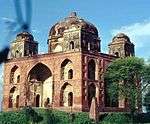History of Sirhind
Sirhind is the older and more popular name of Fatehgarh Sahib. It is situated on the Delhi to Lahore Highway. It has a population of about 60,852. It is now a district headquarters in the state of Punjab; the name of the district is Fatehgarh Sahib.
Pre-Mughal Empire History
The antiquity of the city is traceable to the beginning of the Common era. It was a military outpost of Prithviraj Chauhan against Muhammad Ghori. In 1192 it became a part of Ghauri Sultanate after the defeat of Prithviraj Chauhan. It was refounded by Emperor Firuz Shah Tughlaq in 1361 AD at the behest of Sayyid Jalaluddin Bukhari, the spiritual guide of that King. He made it a new pargana by dividing the old fief of Samana. Firuz Shah dug a canal from the Sutlej. It was an important stronghold of Delhi Sultanate. In 1415 Khizr Khan the first Sayyid ruler of Delhi, nominated his son Malik Mubarak as a governor of Sirhind. in 1420 Khizr khan defeated insurgent Sarang Khan at Sirhind. In 1451 here, Bahlul Khan Lodhi assumed the title of Sultan under the governorship of Malik Sultan Shah Lodhi.
Under The Mughal Empire


On June 22, 1555, Humayun decisively defeated Sikandar Shah Suri at the Battle of Sirhind and reestablished the Mughal empire. The city reached the zenith of its glory under the Mughal Empire in the seventeenth century. This city was a home of sixteenth-century saint Ahmad Sirhindi, popularly known as Mujadid Alif Sani which means 'Revivor of the Faith in the Second Millennium'. The mausoleum of this saint is still there. Under Akbar it had turned the highest yielding sarkar. Under Sirhind sarkar there were 28 parganas. Due to its prosperity during the Mughal Empire it was known as Sirhind Bāvani which means Sirhind Fifty-two because it yielded a revenue of 52 lakh Rs, i.e. 5 million 200 thousand Rs per year. Emperor Shah Jahan built a famous garden known as Aam khas Bagh.
Baba Banda Singh Bahadur and his Sikh army in 1710 destroyed the city of Sirhind completely and Wazir Khan the governor, was killed in the Battle of Chappar Chiri. Sikhs occupied Sirhind and made Bhai Baj Singh the governor.
Maratha conquest
Adina Beg Khan, along with Sikhs was already in revolt with Ahmad Shah Abdali who had invaded Punjab multiple times. He asked Marathas for help, On 7 March, 1758, Marathas at that time were the paramount power in India, Maratha general, Raghunathrao had encamped at Rajpura where he received Adina Beg Khan’s envoys, and was informed that the latter, accompanied by Sikh militias, belonging to the bands of Jassa Singh Ahluwalia and Ala Singh of Patiala had closed upon Sirhind from the other side of Satluj. A concerted attack on the fort of Sirhind was made by the Marathas on 8 March 1758. Ahmad Samad Khan, with his 10,000 Afghan troops, held out for about two weeks before his capitulation on 21 March. After the victory, the town was thoroughly sacked by the victors. After defeating the Afghan-Rohilla forces, the Marathas pursued the Afghans into the Punjab.
Sirhind and Sikhs
Under the orders of the faujdar, Nawab Wazir Khan, Guru Gobind Singh`s two younger sons, aged nine and five, were cruelly done to death.
They were enclosed alive in a wall in Sirhind and executed as the masonry rose up to their necks. Sirhind was for this reason the accurst city in the eyes of the Sikhs. Mobilized under the flag of Banda Singh Bahadur after the death of Guru Gobind Singh in November 1708, they made a fierce attack upon Sirhind. The Mughal army was routed and Wazir Khan killed in the battle of Chappar Chiri fought on 12 May 1710. Sirhind was occupied by the Sikhs two days later, and Bhai Baj Singh was appointed governor. The town was, however, taken again by the imperial forces.
The booty was donated for the repair and reconstruction of the sacred shrines at Amritsar demolished by Ahmad Shah. The territories of the Sirhind sarkar were divided among the leaders of the Dal Khalsa, but no one was willing to take the town of Sirhind where Guru Gobind Singh`s younger sons were subjected to a cruel fate. By a unanimous will it was made over to Buddha Singh, descendant of Bhai Bhagatu, who soon after (2 August 1764) transferred possession to Sardar Ala Singh, founder of the Patiala family. Sirhind thereafter remained part of the Patiala territory until the state lapsed in 1948.
Maharaja Karam Singh of Patiala (1813–45) had gurdwaras constructed in Sirhind in memory of the young martyrs and their grandmother, Mata Gujari. He changed the name of the nizamat or district from Sirhind to Fatehgarh Sahib, after the name of the principal gurdwara. Besides the Sikh shrines, Sirhind has an important Muslim monument Rauza Sharif Mujjadid Alf Sani, the mausoleum of Shaikh Ahmad Sirhindi (1569-1624),the fundamentalist leader of the orthodox; Naqshbandi school of Sufism. There are a number of other tombs in the compound mostly of the members of Shaikh Ahmad`s house.
References
- Sirhind Town(Sahrind) The Imperial Gazetteer of India, v. 23, p. 20.
- Sirhind Canal The Imperial Gazetteer of India, v. 23, p. 18.
- Memories of a town known as Sirhind
